Fort Clatsop, Astoria, OR To bring in the new year, the men fire a volley to awake the captains. Lewis resumes journal writing and issues new orders regulating the garrison’s duties. Clark inventories coastal Indians and ship captains.
A New Year Celebration[1]Originally aired weekdays—Monday, 2 January 2006, for this episode—by Yellowstone Public Radio during the Bicentennial observance of 2003-2006. Narrated by Hal Hansen. Scripts by Whit Hansen and … Continue reading
Fort Clatsop (replica)
© 17 December 2010 by Kristopher K. Townsend. Permission to use granted under the Creative Commons Attribution-Share Alike 4.0 International license. Taken with cooperation from Lewis and Clark National Historic Park, Fort Clatsop.
The New Year
The party Saluted our officers at day break this morning by firing at their quarters as a remembrence of the new year
—John Ordwayat present we were content with eating our boiled Elk and wappetoe, and solacing our thirst with our only beverage pure water.
—Meriwether Lewis
New Orders
the centinel shall be posted, both day and night, on the parade in front of the commanding offercers quarters; tho’ should he at any time think proper to remove himself to any other part of the fort . . . .
the water-gate may be used freely by the Garrison for the purpose of passing and repassing at all times, tho’ from sunset, untill sunrise, it shall be the duty of the centinel, to open the gate for, and shut it after all persons passing and repassing . . . .
—Meriwether Lewis
Crane Fly, Tipula paterifera

Photo © 2002 Bruce Marlin. Permission via the Creative Commons 2.5 License.
Insects
the ticks, flies and other insects are in abundance, which appears to us very extraordinary at this season of the year, in a latitude so far north.
—Patrick Gass
Changing Weather
sometimes tho’ seldom the sun is visible for a few moments the next it hails & rains
—Weather Diary
Anticipation
our repast of this day tho’ better than that of Christmass, consisted principally in the anticipation of the 1st day of January 1807, when in the bosom of our friends we hope to participate in the mirth and hilarity of the day, and when the zest given by the recollection of the present, we shall completely, both mentally and corporally, enjoy the repast which the hand of civilization has prepared for us.
—Meriwether Lewis
Anticipated Ship Captains
A List of the names of Sundery persons, who visit this part of the Coast for the purpose of trade &c. &c. in large Vestles; all of which Speake the English language &c.—as the Indians inform us
. . . .
Mr. Haley Visits them in a Ship & they expect him back to trade with them in 3 moons to trade— he is the favourite of the Indians (from the number of Presents he givs) and has the trade principaly with all the tribes.—
—William Clark
Weather Diary
aspect of the weather at rise
Wind at rise
Weather at 4 OC. P.M. Wind at 4 OC. P.M. cloudy after rain S. W. rain after clouds S. sun visible for a few minutes about 11 A M. the changes of the weather are exceedingly suddon. sometimes tho’ seldom the sun is visible for a few moments the next it hails & rains, then ceases, and remains cloudy the wind blows and it again rains; the wind blows by squalls most generally and is almost invariably from S. W. these visicitudes of the weather happen two three or more times half a day. snake seen 25th Decembr
—Meriwether Lewis[2]To assist the reader, the editor of this web page has omitted the “Day of the month” column and spelled out some abbreviations.
Fort Clatsop is a High Potential Historic Site along the Lewis and Clark National Historic Trail managed by the U.S. National Park Service. The site is managed by the Lewis and Clark National and State Historic Parks.
Notes
| ↑1 | Originally aired weekdays—Monday, 2 January 2006, for this episode—by Yellowstone Public Radio during the Bicentennial observance of 2003-2006. Narrated by Hal Hansen. Scripts by Whit Hansen and Ed Jacobson. Produced by Leni Holliman. © 2003 by Yellowstone Public Radio. |
|---|---|
| ↑2 | To assist the reader, the editor of this web page has omitted the “Day of the month” column and spelled out some abbreviations. |



